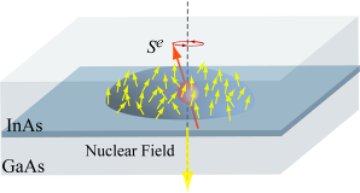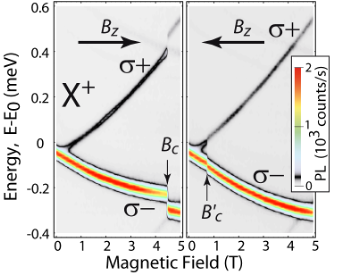In self-assembled InAs/GaAs quantum dots (QDs), level quantization and spatial confinement change dramatically the spin dynamics of electron by suppressing the spin relaxation due to spin-orbit coupling and random scattering present in bulk semiconductors. On the opposite, the confinement enhances the interaction with other local spins, provided by additional charges or magnetic impurities, or by the many nuclear spins from the host material itself. Since more than two decades, it has been clearly demonstrated that the hyperfine interaction with the nuclear spins of InGaAs QDs produces an effective magnetic field (or Overhauser field) experienced by a single electron confined in a quantum dot. This field is random in direction and strength (of the order of a few 10 mT) when the nuclear spins are disordered, and can rise up to ~4T when they are dynamically polarized, notably under cw circularly polarized optical excitation in a longitudinal magnetic field. The spin dynamics of an electron in an InGaAs QD is thus strongly affected by this interaction with a bath of about 10^5 nuclear spins, which gives rise to non-markovian behavior and limits the effective electron spin coherence T2* time to about 2 ns. For application in photonic quantum technologies with InGaAs QDs based on spin-photon entanglement in zero or weak external magnetic field (100mT), this limit is a severe constrain. Our current activities aim to implement protocols enabling us to circumvent this constraint either by using dynamical decoupling techniques, or by preparing the nuclear spin system in a lower state of entropy in a weak magnetic field.
References:
- N. Coste, M. Gundin, D. Fioretto, S. E. Thomas, C. Millet, E. Medhi, M. Gundin, N. Somaschi, M. Morassi, M. Pont, A. Lemaitre, N. Belabas, O. Krebs, L. Lanco, and P. Senellart. Probing the dynamics and coherence of a semiconductor hole spin via acoustic phonon-assisted excitation. Quantum Sci. Technol. 8(2), 025021 mar (2023). doi: 10.1088/2058-9565/acbd6a.
- O. Krebs, E. Baudin, and A. Lemaître. Exchange interaction-driven dynamic nuclear polarization in Mn-doped InGaAs/GaAs quantum dots. Phys. Rev. B 94, 195412 (2016). DOI:10.1103/PhysRevB.94.195412.
- G Sallen, S Kunz, T Amand, L Bouet, T Kuroda, T Mano, D Paget, O Krebs, X Marie, K Sakoda, and B Urbaszek. Nuclear magnetization in gallium arsenide quantum dots at zero magnetic field. Nat. Commun. 5, 3268 February (2014). 10.1038/ncomms4268.
- B. Urbaszek, X. Marie, T. Amand, O. Krebs, P. Voisin, P.Maletinsky, A. Högele, and A. Imamoglu. Nuclear spin physics in quantum dots : an optical investigation. Review of Modern Physics 85, 79 (2013). preprint sur arXiv:1202.4637.
- O. Krebs, P. Maletinsky, T. Amand, B. Urbaszek, A. Lemaître, P. Voisin, X. Marie, and A. Imamoglu. Anomalous Hanle Eff ect due to Optically Created Transverse Overhauser Field in Single InAs/GaAs Quantum Dots. Phys. Rev. Lett. 104, 056603 (2010).

